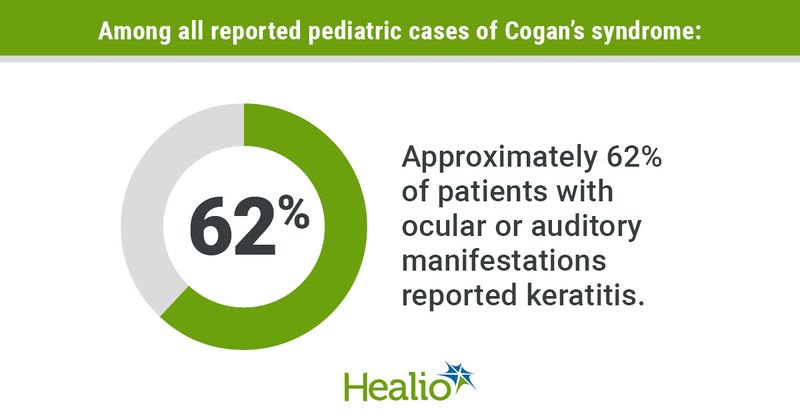Children with Cogan’s syndrome should undergo infectious disease screening, brain MRI
Key takeaways:
- There are no diagnostic or management recommendations for children with Cogan’s syndrome.
- All patients reported auditory or ocular manifestations.
Children with Cogan’s syndrome should undergo thorough evaluations upon presentation, including screenings for autoimmune and infectious diseases, as well as echocardiography and brain MRI, according to data.
“So far, only approximately 300 adults with [Cogan’s syndrome (CS)] have been reported (Orphanet) and it is even more rare in children,” Kristina Rücklová, PhD, of Charles University, in the Czech Republic, and colleagues wrote in Pediatric Rheumatology. “Hence, counselling as well as therapeutic decision making may be challenging especially in the pediatric population.”

To investigate confirmed cases of Cogan’s syndrome and ways in which patient care may be improved, Rücklová and colleagues conducted a literature review of case reports using PubMed, specifically searching the keywords “children,” and “childhood” in addition to those denoting the disease state. In addition to the cases found in the literature review, the researchers added information from a pediatric patient with Cogan’s syndrome treated at their hospital.
The researchers found 55 published case reports of pediatric patients with Cogan’s syndrome. Every patient represented by a case report presented with “sensorineural hearing deficit and ocular involvement,” the researchers wrote. Of these, the most common manifestation was keratitis — in 62% of reports — followed by uveitis — in 36% of reports.
Patients reported vestibular symptoms, including tinnitus and vertigo, 69% of the time. According to the authors, these were sometimes associated with vomiting. Fevers were reported by 29% of patients, arthralgias or arthritis by 45%, neurological involvement by 31%, and skin involvement by 18%. Out of the 55 cases, two patients died.
The most common therapy employed for these patients was systemic corticosteroids, which were used in 81% of cases. Methotrexate was the next most common therapy — used in 26% of patients. The researchers noted that only two patients were treated using a biologic therapy — infliximab (Remicade, Janssen).
“So far no diagnostic and management recommendations for CS in children have been published,” Rücklová and colleagues wrote. “Unfortunately, there is no single laboratory test that would be diagnostic for CS.
“The outcome of pediatric CS patients proved good regarding their ocular involvement with 69% achieving remission but rather unsatisfactory with respect to hearing deficit, with 56% children remaining deaf or severely affected,” they added. “Based on the review of literature we suggest a rational diagnostic work-up for pediatric CS that should include laboratory autoimmune and infectious screening as well as echocardiography and MRI of the brain and the inner ear with gadolinium enhancement.”
